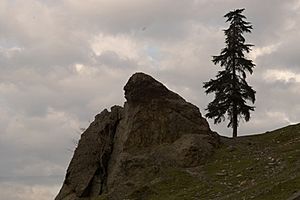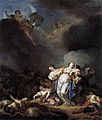Niobe facts for kids
In Greek mythology, Niobe was a princess. She was the daughter of Tantalus, who was sometimes called the "King of Phrygia". Tantalus ruled in a city called Sipylus, located in Anatolia (modern-day Turkey). Niobe was an Anatolian princess. She married Amphion, who was the king of Thebes. Niobe was also the sister of Pelops, who gave his name to the Peloponnese region. Her story is a mix of ancient history and legend.
Contents
Niobe's Pride and Punishment
Niobe was very proud of her many children. She had seven sons and seven daughters, making a total of fourteen children. She often boasted that she was better than the goddess Leto. Leto only had two children, the twins Apollo and Artemis.
Niobe once said, "Why should you honor Leto more than me? My father was a king, and my mother was a goddess. I have fourteen children, while Leto only has two! I am very lucky, and I will stay lucky!"
This boasting made the goddess Leto very angry. To punish Niobe for her pride, Leto sent her powerful children, Apollo and Artemis. Apollo used his poisoned arrows to kill all of Niobe's sons. Artemis then used her own poisoned arrows to kill all of Niobe's daughters. It is said that one child might have been spared, but most stories say all were killed.
Niobe's husband, Amphion, was so sad that he either took his own life or was killed by Apollo.
The Weeping Rock
Niobe was completely heartbroken after losing her entire family. She fled to Mount Sipylus in Lydia, which is in Anatolia. There, she was turned into a stone. Even as a stone, she continued to weep endlessly.
On Mount Sipylus, there is a natural rock formation that looks like a woman's face. People believe this is Niobe. This rock is also known as the "Weeping Stone." It appears to weep because it is made of limestone, which is a porous rock. Rainwater seeps through its tiny holes, making it look like tears are flowing, especially in the summer.
Niobe's Story in Ancient Times
The story of Niobe is very old and well-known among the ancient Greeks. She is mentioned in Homer's famous poem, the Iliad. In the Iliad, the hero Achilles talks about Niobe as an example of someone who grieves deeply.
Niobe's story also appears in the play Antigone by Sophocles. The character Antigone compares her own sadness and loneliness to Niobe's. Other ancient writers, like Aeschylus and Sappho, also wrote about Niobe.
Artists throughout history have been inspired by Niobe's tragic story. Her tale, especially the part about her children being destroyed, was often shown in ancient Greek vase paintings and sculptures. Later, Roman artists also carved her story onto sarcophagi (stone coffins).
Even much later, in William Shakespeare's play Hamlet, the character Hamlet mentions Niobe. He compares his mother's tears for his dead father to Niobe's endless weeping.
Images for kids
-
Daughter of Niobe bent by terror, in the Niobe room at the Uffizi gallery
-
A 1760 painting by Richard Wilson
-
A Niobe statue at Harry Houdini's Grave in New York City
See also
 In Spanish: Níobe para niños
In Spanish: Níobe para niños









